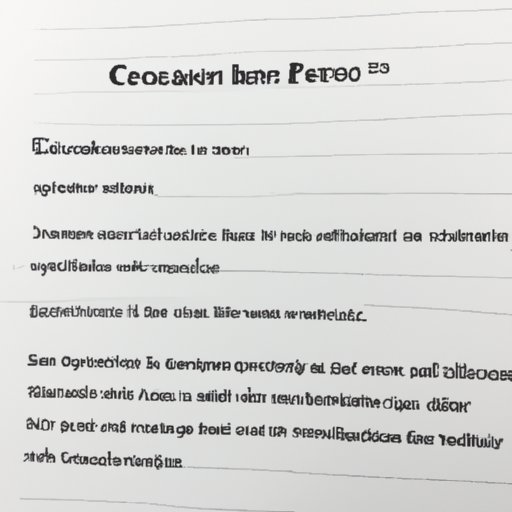Introduction
The Free Exercise Clause is a fundamental protection enshrined in the First Amendment of the United States Constitution. It guarantees the right of citizens to practice any religion of their choosing, free from government interference or regulation. Although the Free Exercise Clause was initially intended to protect religious minorities from persecution, it has since been interpreted to apply to all religions, including those that are not widely practiced. As a result, the Free Exercise Clause has become an important tool for protecting religious liberty.

Examining the Origins and Legal Significance of the Free Exercise Clause
The Free Exercise Clause was adopted as part of the Bill of Rights in 1791, in response to the concerns of religious minorities who were persecuted by the colonial governments. Throughout the 19th century, the Supreme Court interpreted the clause narrowly, ruling that it only applied to laws that targeted religious practices specifically. However, in the 20th century, the Court began to interpret the clause more broadly, ruling that it applied to any law that placed a substantial burden on religious practice.
The Supreme Court has issued several important rulings related to the Free Exercise Clause. In Sherbert v. Verner (1963), the Court held that the government must demonstrate a “compelling interest” in order to justify a law that substantially burdens religious practice. This ruling established a high standard for the government to meet in defending any law that affects religious practice. In Employment Division v. Smith (1990), the Court significantly narrowed this standard, ruling that the government need only show that a law serves a “rational basis” in order to limit religious practice. This ruling caused considerable controversy, as many argued that it allowed the government to infringe upon religious liberty too easily.
Exploring the Impact of Recent Court Decisions on the Free Exercise Clause
The Supreme Court’s decision in Employment Division v. Smith had a significant impact on the interpretation of the Free Exercise Clause. The ruling essentially made it easier for the government to limit religious practice, as long as the law served some legitimate purpose. This decision was highly controversial, and sparked a debate over the scope of religious freedom in the United States.
In 2014, the Supreme Court issued another important ruling related to the Free Exercise Clause in Burwell v. Hobby Lobby. In this case, the Court ruled that closely-held corporations could be exempt from certain regulations if they violated the owners’ religious beliefs. This ruling was widely seen as a victory for religious liberty, as it established that businesses could not be forced to violate their religious beliefs in order to comply with government regulations.
Analyzing the Interplay Between the Free Exercise Clause and Other Constitutional Provisions
The Free Exercise Clause does not exist in a vacuum; it interacts with other constitutional provisions in a variety of ways. Perhaps the most important relationship is between the Free Exercise Clause and the Establishment Clause, which prohibits the government from promoting any particular religion. This relationship is important because it ensures that the government cannot use the Free Exercise Clause as an excuse to promote one religion over another.
The Free Exercise Clause also interacts with the Equal Protection Clause, which requires the government to treat all citizens equally. This interaction is important because it means that the government cannot discriminate against individuals on the basis of their religious beliefs. For example, the government cannot grant special privileges to certain religions while denying them to others.

Understanding How the Free Exercise Clause is Applied in Different Contexts
The Free Exercise Clause applies in a variety of contexts, ranging from education to healthcare. In the educational context, the Free Exercise Clause protects the right of students to practice their religion in school. For example, students have the right to wear religious symbols such as headscarves or yarmulkes without fear of discrimination. In the healthcare context, the Free Exercise Clause protects the right of patients to receive treatment that is consistent with their religious beliefs.

Debating the Role of the Free Exercise Clause in Balancing Religious Freedom with Other Interests
The Free Exercise Clause has been the subject of much debate, as it is often used to balance religious freedom with other interests. On one side of the debate, there are those who argue that the Free Exercise Clause should be interpreted broadly in order to protect religious liberty. On the other side, there are those who argue that the Free Exercise Clause should be interpreted narrowly in order to prevent the government from granting special privileges to certain religions.
Ultimately, the debate over the Free Exercise Clause is likely to continue for some time. Proponents of religious liberty will continue to argue for a broad interpretation of the clause, while those who oppose special privileges for certain religions will advocate for a narrow interpretation. Whatever the outcome, the Free Exercise Clause will remain an important tool for protecting religious freedom in the United States.
Conclusion
The Free Exercise Clause is an essential protection enshrined in the First Amendment of the United States Constitution. It guarantees the right of citizens to practice any religion of their choosing, free from government interference or regulation. The Free Exercise Clause has been the subject of much debate, as it is often used to balance religious freedom with other interests. Ultimately, the Free Exercise Clause remains an important tool for protecting religious liberty in the United States.


